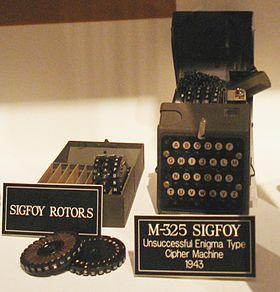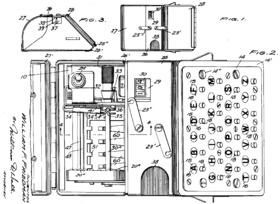 The M-325 (SIGFOY) cipher machine was inspired by the German Enigma | |
| Date invented | 1944[1] |
|---|---|
| Type | rotor machine |
In the history of cryptography, M-325, also known as SIGFOY,[2] was an American rotor machine designed by William F. Friedman and built in 1944.[3] Between 1944 and 1946, more than 1,100 machines were deployed within the United States Foreign Service. Its use was discontinued in 1946 because of faults in operation. Friedman applied for a patent on the M-325 on 11 August 1944; [4] it wasand was granted on 17 March 1959 (US patent #2,877,565).
Like the Enigma, the M-325 contains three intermediate rotors and a reflecting rotor.
See also
References
- ^ F.L. Bauer (9 March 2013). Decrypted Secrets: Methods and Maxims of Cryptology. Springer Science & Business Media. pp. 133–. ISBN 978-3-662-03452-1.
- ^ Friedrich Ludwig Bauer (2002). Decrypted Secrets: Methods and Maxims of Cryptology. Springer Science & Business Media. pp. 137–. ISBN 978-3-540-42674-5.
- ^ Karl Maria Michael de Leeuw; Jan Bergstra (28 August 2007). The History of Information Security: A Comprehensive Handbook. Elsevier. pp. 407–. ISBN 978-0-08-055058-9.
- ^ Friedrich L. Bauer (24 November 2006). Decrypted Secrets: Methods and Maxims of Cryptology. Springer Science & Business Media. pp. 151–. ISBN 978-3-540-48121-8.
Further reading
- Louis Kruh, Converter M-325(T), Cryptologia 1, 1977, pp143–149.
External links
- Operating and Keying Instructions for Converter M-325(T) Headquarters, Army Security Agency, July 1948, scanned and transcribed by Bob Lord.
- Friedman M-325 — information and photographs.
- U.S. Patent 2,877,565
